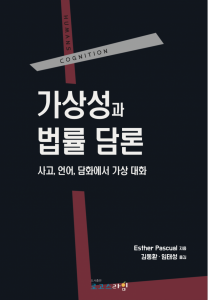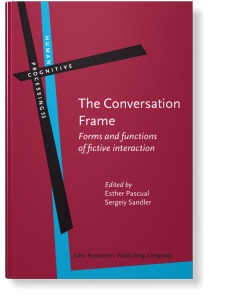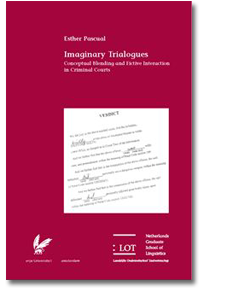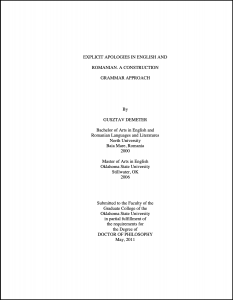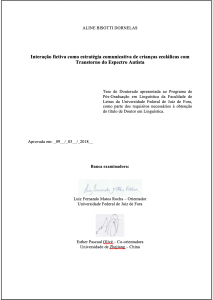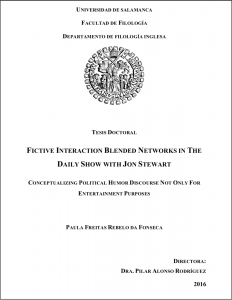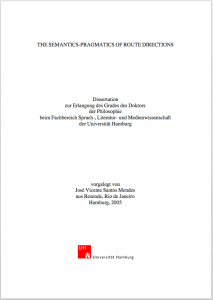FI: Overviews | FI as cognitive phenomenon | FI as linguistic construction | FI as discursive device | FI as communicative strategy
FI: Overviews
Oakley, T. (by invitation). 2016. Conceptual Integration and Fictive Interaction. Literary Universals Project, University of Connecticut, USA.
Pascual, E. 2002. Imaginary Trialogues: Conceptual Blending and Fictive Interaction in Criminal Courts. Utrecht: LOT Dissertation Series.
[Summary in: The International Journal of Speech Language and the Law: Forensic Linguistics 11(1): 169-172, 2004]
[Reviews in: Pragmatics, 13(4): 578-579, 2003, and Lista de Distribución de Lingüística del Español [Spanish Linguistics list], 23 April 2007]
Pascual, E. 2014. Fictive Interaction: The Conversation Frame in Thought, Language, and Discourse. Amsterdam & Philadelphia: John Benjamins.
[Website, with endorsements] [Reviews: Cognitive Semiotics (2015, 8(1); Cognitive Linguistics, 2015, 26(4); Lingüística 2015, 31(2)]
[Korean translation by Donghwan Kim and Taeseong Lim, © 2020 by Logos-Lime Publishing Co.]
Pascual, E. (by invitation) 2016. Fictieve interactie. In A. Reuneker, R.J.U. Boogaart & S.E. Lensink. Aries Netwerk: Een constructicon. Leiden: Leiden University, 158–160. [Final draft]
Pascual, E. & T. Oakley (by invitation). 2017, 2021. Fictive interaction. In B. Dancygier (ed.). Cambridge Handbook of Cognitive Linguistics. Cambridge: Cambridge University Press, 347–360. [Final draft]
Pascual, E. & S. Sandler (eds.). 2016. The Conversation Frame: Forms and Functions of Fictive Interaction. Amsterdam & Philadelphia: John Benjamins.
[Website, with endorsements] [Reviews: Language and Dialogue, 2017 ; Language and Cognition, 2018; Review of Cognitive Linguistics, 2018]
[Korean translation by Donghwan Kim and Taeseong Lim, © 2021 by Logos-Lime Publishing Co.]
Pascual, E. & S. Sandler. 2016. Fictive interaction and the conversation frame: An overview. In E. Pascual & S. Sandler (eds.). The Conversation Frame: Forms and Functions of Fictive Interaction. Amsterdam & Philadelphia: John Benjamins, 3–22. [Final draft]
Pascual, E. 2020, 2021. Todd Oakley, Rhetorical Minds: Meditations on the Cognitive Science of Persuasion, New York and Oxford: Berghahn Books, 2020; x + 318 pp. Discourse Studies 23(1): 110-112.
FI as cognitive phenomenon
Abrantes, A.M. 2009. Fictive interaction as an instance of theatricality in cognition. (24 May 2009). SSRN: http://dx.doi.org/10.2139/ssrn.1409396
Abrantes, A.M. 2021. Telling vs. showing: Imagined dialogues, the conversation frame, and sense making in the arts. In P. Hanenberg & W. Hallet (eds.). Cognition, Culture, and the Arts: Interdisciplinary Perspectives on Narrating, Understanding, and Reading. Berlin: Peter Lang, 79-91.
Abrantes, A.M. & E. Pascual. 2019 (by invitation). Talk this dance: On the conceptualisation of dance as fictive conversation. In Richard Kemp & Bruce McConachie (eds.). The Routledge Companion to Theatre, Performance, and Cognitive Science. Oxford: Taylor & Francis Group Ltd., 255-263. [Final draft]
Antović, M. 2018. Waging war against oneself: A conceptual blend at the heart of Christian ascetic practice. In P. Chilton & M. Kopytowska (Eds.). Religion, Language, and the Human Mind. New York: Oxford University Press, pp. 386-406. [Abstract]
Brandt, L. 2008. A semiotic approach to fictive interaction as a representational strategy in communicative meaning construction. In T. Oakley & A. Hougaard (eds.). Mental Spaces in Discourse and Interaction. Amsterdam: John Benjamins, 110-148.
Brandt, L. 2010. Language and Enunciation: A Cognitive Inquiry with Special Focus on Conceptual Integration in Semiotic Meaning Construction. Ph.D. dissertation, Aarhus University.
Brandt, L. 2013a. Metaphor and the communicative mind. Journal of Cognitive Semiotics 1-2(5): 37-72. [Available at SSRN: https://ssrn.com/abstract=2388214 and http://dx.doi.org/10.2139/ssrn.2388214]
Brandt, L. 2013b. The Communicative Mind: A Linguistic Exploration of Conceptual Integration and Meaning Construction. Newcastle upon Tyne: Cambridge Scholars Publishing. [Review: Cognitive Linguistics, 2015]
Dutilh Novaes, C. & R. French. 2018. Paradoxes and structural rules from a dialogical perspective. Philosophical Issues 28(1): 129-158.
Geurts, B. First saying, then believing: The pragmatic roots of folk psychology. Mind & Language 36(4): 515-532.
Oakley, T. 2014. Semantic domains in the Dream of the Rood. In Brandt, L., Mey, J. L. & Rosenbaum, B. (eds.). Con Moto Ma Non Presto – For Per Aage Brandt 26. april 2014. RASK International Journal for Language and Communication 40: 331-352.
Oakley, T. & P.Aa. Brandt. 2009. Hypotyposis: Meta-representation, mind-reading, and fictive interaction. In W. Wildgen & B. van Heusden (eds). Metarepresentation, Self-Organization and Art. Berlin: Peter Lang.
Oakley, T. 2020. Rhetorical Minds: Meditations on the Cognitive Science of Persuasion. Oxford & New York: Berghahn Books.
Pagán Cánovas, C. & M. Turner. 2016. Generic Integration Templates for fictive conversation. In E. Pascual & S. Sandler (eds.). The Conversation Frame: Forms and Functions of Fictive Interaction. Amsterdam & Philadelphia: John Benjamins, 45–62.
Pascual, E. 2008a. Fictive interaction blends in everyday language and courtroom settings. In T. Oakley & A. Hougaard (eds). Mental Spaces Approaches to Discourse and Interaction. Amsterdam: John Benjamins, 79–107.
Stec, K. 2011. Simulating Fictive Interaction Modifiers. MA Thesis. Aarhus University, Denmark.
Sullivan, K. 2009. The languages of art: How representational and abstract painters conceptualize their work in terms of language. Poetics Today 30(3): 517-560.
Sullivan, K. 2016. Silent abstractions versus “Look at me” drawings: Corpus evidence that artworks’ subject matter affects their fictive speech. In E. Pascual & S. Sandler (eds). The Conversation Frame: Forms and Functions of Fictive Interaction. Amsterdam & Philadelphia: John Benjamins, 87–109.
Turner, M. 2010. Ten Lectures on Mind and Language. Beijing: Foreign Language Teaching and Research Press, 110-111.
Xiang, M. 2016. Real, imaginary, or fictive? Philosophical dialogues in an early Daoist text and its pictorial version. In E. Pascual & S. Sandler (eds.). The Conversation Frame: Forms and Functions of Fictive Interaction. Amsterdam & Philadelphia: John Benjamins, 63–86. [Final draft]
FI as linguistic construction
Alekseenko, N. V. 2017. ФЕНОМЕН ФИКТИВНОЙ КОММУНИКАЦИИ В ПОЛИМОДАЛЬНОМ АСПЕКТЕ [Fictive interaction from a multimodal perspective]. Вестник МГЛУ. Гуманитарные науки. [MSLU Bulletin: Humanitarian sciences] Vol. 6 (777): 202-215.
Alekseenko, N. V. 2018. ОСОБЕННОСТИ ВЕРБАЛИЗАЦИИ ФИКТИВНОЙ ИНТЕРАКЦИИ В РУССКОМ ЯЗЫКЕ [Verbalization of fictive interaction in the Russian language]. Вестник МГЛУ. Гуманитарные науки. [MSLU Bulletin: Humanitarian sciences] Vol. 4 (793): 82-93.
Brandt, L. 2013. The Communicative Mind: A Linguistic Exploration of Conceptual Integration and Meaning Construction. Newcastle upon Tyne: Cambridge Scholars Publishing.
da Costa Junior, J.C. & L.F.M. Rocha. 2018. Compostos de discurso direto no português do Brasil: Interação fictiva no léxico. Diacrítica 32: 159-178.
Ehmer, O. S. 2011. Imagination und Animation: die Herstellung mentaler Räume durch animierte Rede. Berlin, New York: Walther de Gruyter.
Geurts, B. 2021. First saying, then believing: The pragmatic roots of folk psychology. Mind & Language 36(4): 515-532.
Janssen, Th.A.J.M. 2003. Inspirerend ‘Nederlands’? Een pleidooi voor doorstroom van kennis over taal. Nederlandse Taalkunde 8: 301-314.
Janssen, Th.A.J.M. 2006a. (Ad)mirativiteit in het Nederlands. Feestbundel voor Ad Zuiderent.
Janssen, Th.A.J.M. 2006b. De focusconstructies moet je eens kijken en kijk eens. Nederlandse Taalkunde 11/4, 332-365.
Janssen, Th.A.J.M. 2007. A speaker/hearer-based grammar: The case of possessives and compounds. In M. Hannay and G. Steen (eds.). Structural-Functional Studies in English Grammar. Amsterdam: John Benjamins, 353-387.
Janssen, Th.A.J.M. & E. Pascual. 2005. Doe-het-zelfsamenstellingen: De opkomst van zin-woordcombinaties [Do-it-yourself compounds: The emergence of sentence-word combinations]. Onze Taal 74(5): 112-114. [Referred to in: www.kennislink.nl]
Jarque, M.J. 2016. What about? Fictive question-answer pairs for non-information-seeking functions across signed languages. In E. Pascual & S. Sandler (eds). The Conversation Frame: Forms and Functions of Fictive Interaction. Amsterdam and Philadelphia: John Benjamins, 171–192. [Final draft]
Jarque, M.J. & E. Pascual (by invitation). 2015. Direct discourse expressing evidential values in Catalan Sign Language. In J. Martines & V. Miglio (guest eds.). Special issue on ‘Evidentiality in Iberian languages’. eHumanista/IVITRA 8: 421-445.
Jarque, M.J. & E. Pascual. 2016. Mixed viewpoints in factual and fictive discourse in Catalan Sign Language narratives. In B. Dancygier, L. Wei-lun-Lu & A. Verhagen (eds.). Viewpoint and the Fabric of Meaning: Form and Use of Viewpoint Tools across Languages and Modalities. Berlin: Mouton de Gruyter, pp. 259-280. [Final draft]
Jarque, M.J. 2019. Interactional view of language. In Grounding, Subjectivization and Deixis: Modal Constructions in Catalan Sign Language and their Interaction with other Semantic Domains. Ph.D. dissertation, University of Barcelona, 94–95.
Jarque, M.J. 2019. Quotative evidential constructions. In Grounding, Subjectification and Deixis: Modal Constructions in Catalan Sign Language and their Interaction with other Semantic Domains. Ph.D. dissertation, University of Barcelona, 462–475.
Jarque, M.J. 2019. Sources of evidential constructions. In Grounding, Subjectivization and Deixis: Modal Constructions in Catalan Sign Language and their Interaction with other Semantic Domains. Ph.D. dissertation, University of Barcelona, 716–717.
Jarque, M.J. & E. Pascual. 2021 (by invitation). From gesture- and sign-in-interaction to grammar: Fictive questions for relative clauses in signed languages. Languages and Modalities 1: 81-93.
Królak, E. 2008. Fictive interaction: Its Functions and Usage in Discourse. Ph.D. Dissertation, University of Warsaw.
Królak, E. 2016. A Polish nominal construction involving fictive interaction: Its scope and functions in discourse. In E. Pascual & S. Sandler (eds.). The Conversation Frame: Forms and Functions of Fictive Interaction. Amsterdam and Philadelphia: John Benjamins, 235–253. [Final draft]
Królak, E. & A. Wiechecka. 2019. Rochatypu “Jestem Tego Warta” (‘“I’m-Worth-It” attitude’) – Selected pragmatic functions of nominal constructions involving direct speech in Polish. In I.M. Lehman & S. Kossakowska-Pisarek (eds.). Manifesting Identity in Cultural and Academic Discourses. Łódź: Społeczna Akademia Nauk, 27-40.
Oakley, T. & V. Tobin. 2014. The whole is sometimes less than the sum of its parts: Toward a theory of document acts. Language and Cognition 6(1): 79–110.
Pascual, E. 2006b. Fictive interaction within the sentence: A communicative type of fictivity in grammar. Cognitive Linguistics 17(2): 245–267.
Pascual, E. 2010 (by invitation). El concepto de interacción ficticia en español: De la conversación a la gramática [Fictive interaction in Spanish: From conversation to grammar]. Dialogía: Revista de Lingüística, Literatura y Cultura 5: 64-98.
Pascual, E. & Th.A.J.M. Janssen. 2004. Zinnen in samenstellingen: presentaties van fictieve verbale interactie [Sentences within compounds: Presentations of fictive verbal interaction]. Nederlandse Taalkunde 9(4): 285-310.
Pascual, E. & E. Królak. 2018. The ‘listen to characters thinking’ novel: Fictive interaction as narrative strategy in literary bestsellers and their Spanish and Polish translations. Review of Cognitive Linguistics 16 (2): 399–430. [Final draft]
Pascual, E., E. Królak & Th.A.J.M. Janssen. 2013. Direct speech compounds: Evoking socio-cultural scenarios through fictive interaction. Cognitive Linguistics 24(2): 345–366.
Pascual, E. & B. Marqueta. 2023. (2023, 2024). Viewpointed morphology: Spanish verb-complement compounds as fictive interaction constructions. Journal of Linguistics 60: 1-31. [Final draft]
Posio, P. & M. Rosemeyer. 2024. Dialogical and monological functions of the discourse marker bueno in spoken and written Spanish. Linguistics, https://doi.org/10.1515/ling-2023-0113
Rocha, L.F.M. 2003. Tendências prosódicas e interacionais do discurso reportado: uma abordagem sociocognitivista. VEREDAS 7(1-2): 247–262.
Rocha, L.F.M.. 2006. A fala silenciosa reportada: metáfora, metonímia e mesclagem. Lingüística (PPGL/UFRJ) 2: 35-42.
Rocha, L.F.M. 2008. Comunicação e cognição: discurso (re)portado ou discurso (re)construído?. Lumina, Juiz de Fora (MG) 6(1/2): 101-116.
Rocha, L.F.M. 2012a. Autocitação fictiva como escaneamento mental: Mover-se conceptualmente sem se deslocar. Revista da ABRALIN (Associação Brasileira de Linguística) 11(2): 113–143.
Rocha, L.F.M. 2012b. Construal operations in fictive and factive selfquotation. DELTA Documentação de Estudos em Lingüística Teórica e Aplicada 29(2): 311-339.
Rocha, L.F.M. 2013. A perspectivação conceptual em autocitação factiva e fictiva. D.E.L.T.A. 29(2): 311-339.
Rocha, L.F.M. 2014. Autocitação fictiva em português europeu e brasileiro. Alfa: Revista de Linguística (UNESP. Online) 58: 63-92.
Rocha, L.F.M & P. Arantes. 2016. Intonation of fictive vs. actual direct speech counterparts in a Brazilian Portuguese corpus. In E. Pascual & S. Sandler (eds). The Conversation Frame: Forms and Functions of Fictive Interaction. Amsterdam & Philadelphia: John Benjamins, 215–234.
Rocha, L.F.M. 2020. Discurso reportado é problema; interação fictiva, solução: padrões discursivos e informacionais em corpus de fala espontânea do PB. Lingüística 36(2): 131-149.
Rocha, L.F.M. & J.D. Silva. 2023. Interação Fictiva como exemplificação em discurso direto: ensino-aprendizagem de português como língua estrangeira [Fictive interaction as exemplification in direct speech: teaching and learning of portuguese as a foreign language]. Gragoatá 28(62), DOI10.22409/gragoata.v28i62.574.
Sandler, S. & E. Pascual. 2019. (by invitation). In the beginning there was conversation: Fictive speech in the Hebrew Bible. In C. Gentens, M.S. Sansiñena, S. Spronck & A. Van linden (guest eds.). Special issue ‘Irregular perspective shifts and perspective persistence: Discourse-oriented and theoretical approaches’. Pragmatics 29(2): 250–276. [Final draft]
Spronck, S. 2015. Reported Speech in Ungarinyin: Grammar and Social Cognition in a Language of the Kimberley Region, Western Australia. Ph.D. Dissertation, The Australian National University.
Spronck, S. 2016. Evidential fictive interaction in Ungarinyin and Russian. In E. Pascual & S. Sandler (eds.). The Conversation Frame: Forms and Functions of Fictive Interaction. Amsterdam & Philadelphia: John Benjamins, 255–275.
Spronck, S. & D. E. Casartelli. 2021. In a manner of speaking: How reported speech may have shaped grammar. Frontiers in Communication – Language Sciences. https://doi.org/10.3389/fcomm.2021.624486
Spronck, S. & T. Nikitina. 2019. M and R as elements of a syntactic unit: Where would the relation between M and R come from, if not from syntax? Linguistic Typology 23(1): 245–254. [Final draft]
Stec, K., M. Huiskes & G. Redeker. 2015. Multimodal analysis of quotation in oral narratives. Open Linguistics 1: 531–554. [url]
Verhagen, A. 2021. Verbeelding in taal − Een Jip-en-Janneke-perspectief. Afscheidsrede. Universiteit Leiden, 11 oktober 2021. [url] [downloadable pdf]
Voort, H. van der. 2009. Reduplication and repetition of person markers in Guaporé isolates. Morphology 19(2): 263–286.
Voort, H. van der. 2013. Fala fictícia fossilizada: O tempo futuro em Aikanã. Boletim do Museu Paraense Emílio Goeldi (Ciências Humanas) 8(2): 359–377.
Voort, H. van der 2016. Recursive inflection and grammaticalized fictive interaction in the southwestern Amazon. In E. Pascual & S. Sandler (eds.). The Conversation Frame: Forms and Functions of Fictive Interaction. Amsterdam & Philadelphia: John Benjamins, 277–299.
Vries, L. de. 2010. Direct speech, fictive interaction, and bible translation. The Bible Translator 61(1): 31-40.
de Vries, R. 2014. “Een experimenteel onderzoek naar de communicatieve effectiviteit van directe rede samenstellingen in productadvertenties” [An experimental study of the communicative effectiveness of direct speech compounds in product advertisements]. Master thesis, Dept. Communication and Information Studies, Rijksuniversiteit Groningen.
FI as discursive device
Coulson, S. & T. Oakley. 2006. Purple persuasion: Deliberative rhetoric and conceptual blending. In J. Luchjenbroers (ed). Cognitive Linguistics Investigations: Across Languages, Fields, and Philosophical Boundaries. Amsterdam & Philadelphia: John Benjamins, 47–65.
Coulson, S. & E. Pascual. 2006. For the sake of argument: Mourning the unborn and reviving the dead through conceptual blending. Annual Review of Cognitive Linguistics 4: 153-181.
Dancygier B. .2021. Fictive deixis, direct discourse, and viewpoint networks. Frontiers in Communication 6: 624334. doi: 10.3389/fcomm.2021.624334
Demeter, G. 2011. IFID vs. fictive apologies. In Explicit Apologies in English and Romanian: A Construction Grammar Approach. Ph.D. Dissertation, Oklahoma State University, 77–78.
Demeter, G. 2011. Constructions used to construe fictive apologies in the Written English Corpus. In Explicit Apologies in English and Romanian: A Construction Grammar Approach. Ph.D. Dissertation, Oklahoma State University, 168–171.
Demeter, G. 2016. On discourse-motivated ‘sorries’: Fictive apologies in English, Hungarian, and Romanian. In E. Pascual & S. Sandler (eds.). The Conversation Frame: Forms and Functions of Fictive Interaction. Amsterdam & Philadelphia: John Benjamins, 151–168.
FitzGerald, W. & T. Oakley. 2016. Invocation or apostrophe?: Prayer and the conversation frame in public discourse. In E. Pascual & S. Sandler (eds). The Conversation Frame: Forms and Functions of Fictive Interaction. Amsterdam & Philadelphia: John Benjamins, 131–150.
Fonseca, P. 2016. Fictive interaction Blended Networks in The Daily Show with Jon Stewart: Conceptualizing Political Humor Discourse Not Only For Entertainment Purposes. Ph.D. Dissertation, University of Salamanca, Spain.
Fonseca, P., E. Pascual & T. Oakley. 2020. “Hi, Mr. President!”: Fictive interaction blends as a unifying rhetorical strategy in satire. Review of Cognitive Linguistics 18(1): 183–216. [Final draft]
Jarque, M.J. 2019. Modal functions of palm-up form in LSC discourse. In Grounding, Subjectivization and Deixis: Modal Constructions in Catalan Sign Language and their Interaction with other Semantic Domains. Ph.D. dissertation, University of Barcelona, 637–645.
Jarque, M.J. 2019. LSC modals and the grounding function. In Grounding, Subjectivization and Deixis: Modal Constructions in Catalan Sign Language and their Interaction with other Semantic Domains. Ph.D. dissertation, University of Barcelona, 663–673.
Królak, E. 2008. Fictive Interaction: Its Functions and Usage in Discourse. Ph.D. Dissertation, University of Warsaw.
Liang, Y. 2020. “The effect of literacy on the use of direct vs. indirect speech”. Master’s thesis, Dept. of Linguistics, Zhejiang University, China.
Oakley, T. 2020. Rhetorical Minds: Meditations on the Cognitive Science of Persuasion. Oxford & New York: Berghahn Books.
Oakley, T. 2017. Multimodal rhetoric: Fictive interaction strategies in political discourse. In Special issue: ‘Towards a multimodal construction grammar’, guest edited by: E. Zima & A. Bergs. Linguistics Vanguard 3 (s1). doi:10.1515/lingvan-2016-0046
Pascual, E. & E. Królak. 2018. The ‘listen to characters thinking’ novel: Fictive interaction as narrative strategy in literary bestsellers and their Spanish and Polish translations. Review of Cognitive Linguistics 16 (2): 399–430. [Final draft]
Piepers, J., M. van de Groep, H. van Halteren, & H. de Hoop. 2021. “Amsterdam, you’re raining!” First-hand experience in tweets with spatio-temporal addressees. Journal of Pragmatics 176: 97-109. [Final draft]
Rocha, L.F.M. 2008. Comunicação e cognição: Discurso (re)portado ou discurso (re)construído?. Lumina, Juiz de Fora (MG) 6(1/2): 101-116.
Rocha, L.F.M. 2020. Discurso reportado é problema; Interação fictiva, solução: padrões discursivos e informacionais em corpus de fala espontânea do PB. Lingüística 36(2): 131-149.
Rossini Martins Cardoso, R., K. Nunes Pereira Oliva, R. Araújo Castro, M.C. Zuppardi, & I R. Malta. 2021. Fictivity in Vogue: A cognitive-functional categorization of fictive speech acts in a fashion corpus using corpus linguistics. SOLETRAS 41: 343-365.
Sandler, S. (by invitation). Under review. Language as literature: Characters use and the conversation frame in everyday spoken discourse. Ms. [Full draft]
Sandler, S. & E. Pascual. 2019. (by invitation). In the beginning there was conversation: Fictive speech in the Hebrew Bible. In C. Gentens, M.S. Sansiñena, S. Spronck & A. Van linden (guest eds.). Special issue ‘Irregular Perspective Shifts and Perspective Persistence’. Pragmatics 29(2): 250–276. [Final draft]
Santos Mendes, J.V. 2005. The Semantics-Pragmatics of Route Directions. Ph.D. Dissertation, University of Hamburg.
Stec, K. 2007. Wait ‘til you Hear the Best Part: Fictive Interaction in Narrative. Undergraduate Honors Thesis. Dept. of Linguistics, University of California.
Xiang, M. 2016. Real, imaginary, or fictive? Philosophical dialogues in an early Daoist text and its pictorial version. In: E. Pascual & S. Sandler (eds.). The Conversation Frame: Forms and Functions of Fictive Interaction. Amsterdam & Philadelphia: John Benjamins, 63–86. [Final draft]
Xiang, M. & E. Pascual. 2016. Debate with Zhuangzi: Expository questions as fictive interaction blends in an old Chinese text. Pragmatics 26(1): 137-162.
Xiang, M. 2018. A Cognitive Rhetorical Analysis of Fictive Questions in the Zhuangzi Text. Ph.D. dissertation, Zhejiang University, China. [Summary, Table of Contents, first chapter]
Xiang, M. 2023. Fictive Questions in the Zhuangzi: A Cognitive Rhetorical Study. Amsterdam & Philadelphia: John Benjamins (Figurative Thought and Language series).
Xiang, M. & B. Ma. 2020. How can I persuade you without making self-assertions? A cognitive rhetorical analysis of the use of fictive questions in an early Daoist text. In Vera da Silva Sinha, Ana Moreno-Núñez & Zhen Tian (eds.). Language, Culture and Identity: Signs of Life. Amsterdam & Philadelphia: John Benjamins, 249-273.
Xiang, M., E. Pascual & B. Ma. 2022. Rhetorical questions as intersubjective mixed viewpoint constructions in an early Daoist text. Journal of Historical Pragmatics 23(1): 29-53. [Final draft]
Weiss, Daniel 2021. “Sorry Banks. Party is over!” Fiktive Zitate im politischen Diskurs [“Sorry Banks. Party is over!” Fictive quotes in political discourse]. In Bernhard Brehmer, Anja Gattnar & Tatjana Perevozchikova. Von A wie Aspekt bis Z wie Zdvořilost: Ein Kaleidoskop der Slavistik für Tilman Berger zum 65 Geburtstag [From A for aspect to Z for Zdvořilost: A kaleidoscope of Slavic studies for Tilman Berger on his 65th birthday]. Tübingen: Tübingen Library Publishing, 217-229.
FI as communicative strategy
Alekseenko, N. V. 2017. ФЕНОМЕН ФИКТИВНОЙ КОММУНИКАЦИИ В ПОЛИМОДАЛЬНОМ АСПЕКТЕ [Fictive interaction from a multimodal perspective]. Вестник МГЛУ. Гуманитарные науки. [MSLU Bulletin: Humanitarian sciences] Vol. 6 (777): 202-215.
Alekseenko, N. V. 2021. Феномен фиктивной коммуникации в дискурсе социального плаката [Fictive interaction phenomenon in social advertising discourse]. Филологические науки. Вопросы теории и практики [Philology Theory & Practice] 14(6): 1866-1871.
Brandt, L. & E. Pascual. 2016. ‘Say hello to this ad’: The persuasive rhetoric of fictive interaction in marketing. In E. Pascual & S. Sandler (eds.). The Conversation Frame: Forms and Functions of Fictive Interaction. Amsterdam & Philadelphia: John Benjamins, 303–322. [Final draft]
Cienki, A. & G. Giansante. 2014. Conversational framing in televised political discourse: A comparison from the 2008 elections in the United States and Italy. In C. Schubert & P. Fischer (guest eds). Special issue of the Journal of Language and Politics 13(2): 255–288.
Coulson, S. & T. Oakley. 2006. Purple persuasion: Deliberative rhetoric and conceptual blending. In J. Luchjenbroers (ed). Cognitive Linguistics Investigations: Across Languages, Fields, and Philosophical Boundaries. Amsterdam & Philadelphia: John Benjamins, 47–65.
Coulson, S. & E. Pascual. 2006. For the sake of argument: Mourning the unborn and reviving the dead through conceptual blending. Annual Review of Cognitive Linguistics 4: 153-181.
da Silva, J. U. & L. F. Matos Rocha. 2023. Interação fictiva em discurso direto: Como e por que líderes religiosos convencem multidões [Fictive interaction in direct speech: How and why religious leaders persuade crowds]. Linguagem em (Dis)curso 23(2), DOI: 10.1590/1982-4017-23-31
Dornelas, A. 2018. Interação Fictiva como Estratégia Comunicativa de Crianças Ecolálicas com Transtorno do Espectro Autista [‘Fictive Interaction as Communicative Strategy by Echolaic Children with Autism Spectrum Disorder’]. Ph.D. dissertation, Federal University of Juiz de Fora, Brazil.
Dornelas, A. & E. Pascual. 2016. Echolalia as communicative strategy: Fictive interactionin the speech of children with autism. In E. Pascual & S. Sandler (eds.). The Conversation Frame: Forms and Functions of Fictive Interaction. Amsterdam & Philadelphia: John Benjamins, 343–361. [Final draft]
Fonseca, P., E. Pascual & T. Oakley. 2020. “Hi, Mr. President!”: Fictive interaction blends as a unifying rhetorical strategy in satire. Review of Cognitive Linguistics 18(1): 183–216.
Kleppa, L-A. 2016. Interações fictivas enquanto estratégia comunicativa em sujeitos com agramatismo: Um estudo de caso [Fictive Interactions as a Communicative Strategy in Speakers with Agrammatism: a Case Study]. Estudos Linguísticos 45(2): 555-565.
Oakley, T. 2017. Multimodal rhetoric: Fictive interaction strategies in political discourse. Linguistics Vanguard 3(1). DOI: https://doi.org/10.1515/lingvan-2016-0046
Oakley, T. 2020. Rhetorical Minds: Meditations on the Cognitive Science of Persuasion. Oxford & New York: Berghahn Books.
Overmars, L. 2014. “Fictive Questions in Courtroom Monologues: Covert Intentions in Closing Arguments and Rebuttals”. BA thesis, Dept. English, Vrije Universiteit Amsterdam.
Pascual, E. 2007. Listening to the evidence: Fictive interaction metaphors as argumentative strategies before the American jury. Proceedings of the 2nd European IAFL Conference on Forensic Linguistics / Language and the Law 2006. Barcelona: IULA, 305-312.
Pascual, E. 2008a. Fictive interaction blends in everyday language and courtroom settings. In T. Oakley & A. Hougaard (eds). Mental Spaces Approaches to Discourse and Interaction. Amsterdam: John Benjamins, 79–107.
Pascual, E. 2008b. Text for context, trial for trialogue: An ethnographic study of a fictive interaction blend. Annual Review of Cognitive Linguistics 6: 50–82.
Pascual, E. 2006a. Questions in legal monologues: Fictive interaction as argumentative strategy in a murder trial. Text & Talk 26(3): 383–402.
Pascual, E. 2004. Triadic questions in court: A case study. Semikolon 4(9): 71-92.
Pascual, E. 2003. Interrogatives in the field: The cognitive ethnopragmatics of a murder trial. Proceedings of the 28th Annual Meeting of the Berkeley Linguistics Society: 451-462.
Pascual, E. 2002. Conversational compressions: Conceptual blending and virtual interaction in phrases. In: A. Hougaard & S.N. Lund (eds.). Odense Working Papers in Language and Communication 23(1): 163-180.
Pascual, E. & C. Versluis. 2006. Verbale demonstratie als strategie van functionele adaptatie bij Broca-afasie: Een gevalstudie [Verbal demonstration as strategy of functional adaptation in Broca’s aphasia: A case study]. Voortgang 24: 169-182.
Pascual, E., A. Dornelas & T. Oakley. 2017 (actual publication date: 2019). When ‘Goal!’ means ‘soccer’: Verbatim fictive speech as communicative strategy by children with autism and two control groups. Pragmatics & Cognition 24(3): 315–345. [Final draft]
Rocha, L.F.M. & J.D. Silva. 2023. Interação Fictiva como exemplificação em discurso direto: ensino-aprendizagem de português como língua estrangeira [Fictive interaction as exemplification in direct speech: teaching and learning of portuguese as a foreign language]. Gragoatá 28(62), DOI10.22409/gragoata.v28i62.574.
van Beveren, S. 2020. Stancetaking in Court: How the Stance Triangle can be used to analyse Stance in Courtroom Opening Statements. Bachelor’s thesis, Vrije Universiteit Amsterdam, July, 2020.
van de Graaf, B. 2018. Fictive Interaction in Opening Statements: A Comparison of the Use of Interactive Linguistic Devices between the Prosecution and Defense. Bachelor’s thesis: VU University Amsterdam. [Full text]
Versluis, C.N. & L.-A. Kleppa. [2008] 2016. The use of interactive structures as communicative strategy in Dutch and Portuguese aphasic speakers. In E. Pascual & S. Sandler (eds). The Conversation Frame: Forms and Functions of Fictive Interaction. Amsterdam & Philadelphia: John Benjamins, 323–342. [Abstract]
Vries, de, R. 2014. “Een experimenteel onderzoek naar de communicatieve effectiviteit van directe rede samenstellingen in productadvertenties” [An experimental study of the communicative effectiveness of direct speech compounds in product advertisements]. Master’s thesis, Dept. Communication and Information Studies, Rijksuniversiteit Groningen.
Xie, F., E. Pascual, & T. Oakley. 2013. Functional echolalia in autism speech: Verbal formulae and repeated prior utterances as communicative and cognitive strategies. Frontiers in Psychology (Language Sciences section) 14: 1010615.

